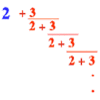Skip over navigation
Solve the quadratic equation $x^2 = 7x + 1$. This equation is equivalent to $x = 7 + \frac{1}{x}$ which has solutions given by the infinite continued fraction
$$ x = 7 + {1\over\displaystyle 7+ { 1\over \displaystyle 7+ { 1\over \displaystyle 7+ \cdots }}}. $$
This is because, if we think of this last equation as being $x = 7 + {1\over y}$, then clearly $y = x$. Show that the sequence of numbers $$7 + {1\over\displaystyle 7}, \quad 7 + {1\over\displaystyle 7+ { 1\over \displaystyle 7}}, \quad 7 + {1\over\displaystyle 7+ { 1\over \displaystyle 7+ { 1\over \displaystyle 7 }}}, \quad \cdots$$ gives better and better approximations to one of the solutions of the original quadratic equation. [Note that to find these approximations you can simply repeat the steps: 'take reciprocal, add 7', over and over again.]
Find integers $a$ and $b$, with $b$ less than 400, such that ${a\over b}$ , is equal to $\sqrt 53$ correct to six significant figures.
Now consider $x^2 = 5x + 1$, ...


Or search by topic
Number and algebra
Geometry and measure
Probability and statistics
Working mathematically
Advanced mathematics
For younger learners
Good Approximations
Age 16 to 18
Challenge Level 





Solve the quadratic equation $x^2 = 7x + 1$. This equation is equivalent to $x = 7 + \frac{1}{x}$ which has solutions given by the infinite continued fraction
$$ x = 7 + {1\over\displaystyle 7+ { 1\over \displaystyle 7+ { 1\over \displaystyle 7+ \cdots }}}. $$
This is because, if we think of this last equation as being $x = 7 + {1\over y}$, then clearly $y = x$. Show that the sequence of numbers $$7 + {1\over\displaystyle 7}, \quad 7 + {1\over\displaystyle 7+ { 1\over \displaystyle 7}}, \quad 7 + {1\over\displaystyle 7+ { 1\over \displaystyle 7+ { 1\over \displaystyle 7 }}}, \quad \cdots$$ gives better and better approximations to one of the solutions of the original quadratic equation. [Note that to find these approximations you can simply repeat the steps: 'take reciprocal, add 7', over and over again.]
Find integers $a$ and $b$, with $b$ less than 400, such that ${a\over b}$ , is equal to $\sqrt 53$ correct to six significant figures.
Now consider $x^2 = 5x + 1$, ...
[See the articles Continued Fractions I and Continued Fractions II. ]
You may also like
There's a Limit
Explore the continued fraction: 2+3/(2+3/(2+3/2+...)) What do you notice when successive terms are taken? What happens to the terms if the fraction goes on indefinitely?
Not Continued Fractions
Which rational numbers cannot be written in the form x + 1/(y + 1/z) where x, y and z are integers?

